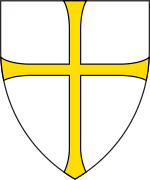Byneset
Byneset is a former municipality in Sør-Trøndelag county, Norway. The 78.5-square-kilometre (30.3 sq mi) municipality existed from 1838 until its dissolution in 1964. The municipality of Byneset encompassed the western part of what is now Trondheim municipality in Trøndelag county. Byneset was located along an arm of the Trondheimsfjord and it was separated from the city of Trondheim by the Bymarka recreation area. The local Byneset Church is one of the oldest stone churches in Norway. The largest village in Byneset was Spongdal which was the administrative centre of the municipality. Other villages included Byneset and Langørjan.[1]
Byneset herred | |
|---|---|
 Sør-Trøndelag within Norway | |
 Byneset within Sør-Trøndelag | |
| Coordinates: 63°22′34″N 10°08′10″E | |
| Country | Norway |
| County | Sør-Trøndelag |
| District | Trondheim Region |
| Established | 1 Jan 1838 |
| Disestablished | 1 Jan 1964 |
| Administrative centre | Spongdal |
| Area | |
| • Total | 78.5 km2 (30.3 sq mi) |
| *Area at municipal dissolution. | |
| Population (1964) | |
| • Total | 2,049 |
| • Density | 26/km2 (68/sq mi) |
| Time zone | UTC+01:00 (CET) |
| • Summer (DST) | UTC+02:00 (CEST) |
| ISO 3166 code | NO-1655 |
| Created as | Formannskapsdistrikt in 1838 |
| Succeeded by | Trondheim in 1964 |
History

The municipality of Byneset was established on 1 January 1838 (see formannskapsdistrikt). According to the 1835 census, there were 2,143 people living in Byneset.[2] In 1855, the southern parish of Buvik (population: 841) was separated from Byneset to form its own municipality. This left Byneset with a population of 2,109.
During the 1960s, there were many municipal mergers across Norway due to the work of the Schei Committee. On 1 January 1964, the neighboring municipalities of Byneset (population: 2,049), Leinstrand (population: 4,193), Strinda (population: 44,600), Tiller (population: 3,595), and the city of Trondheim (population: 56,982) were merged to form the new urban municipality of Trondheim which would have a total population of 111,419.[3]
Government
All municipalities in Norway, including Byneset, are responsible for primary education (through 10th grade), outpatient health services, senior citizen services, unemployment and other social services, zoning, economic development, and municipal roads. The municipality is governed by a municipal council of elected representatives, which in turn elects a mayor.[4]
Municipal council
The municipal council (Herredsstyre) of Byneset was made up of 17 representatives that were elected to four year terms. The party breakdown of the final municipal council was as follows:
| Party Name (in Norwegian) | Number of representatives | |
|---|---|---|
| Labour Party (Arbeiderpartiet) | 4 | |
| Conservative Party (Høyre) | 2 | |
| Christian Democratic Party (Kristelig Folkeparti) | 2 | |
| Centre Party (Senterpartiet) | 9 | |
| Total number of members: | 17 | |
| Party Name (in Norwegian) | Number of representatives | |
|---|---|---|
| Labour Party (Arbeiderpartiet) | 4 | |
| Conservative Party (Høyre) | 1 | |
| Christian Democratic Party (Kristelig Folkeparti) | 3 | |
| Farmers' Party (Bondepartiet) | 9 | |
| Total number of members: | 17 | |
| Party Name (in Norwegian) | Number of representatives | |
|---|---|---|
| Labour Party (Arbeiderpartiet) | 3 | |
| Conservative Party (Høyre) | 1 | |
| Christian Democratic Party (Kristelig Folkeparti) | 3 | |
| Farmers' Party (Bondepartiet) | 7 | |
| Local List(s) (Lokale lister) | 2 | |
| Total number of members: | 16 | |
| Party Name (in Norwegian) | Number of representatives | |
|---|---|---|
| Labour Party (Arbeiderpartiet) | 3 | |
| Christian Democratic Party (Kristelig Folkeparti) | 2 | |
| Farmers' Party (Bondepartiet) | 11 | |
| Total number of members: | 16 | |
| Party Name (in Norwegian) | Number of representatives | |
|---|---|---|
| Labour Party (Arbeiderpartiet) | 4 | |
| Farmers' Party (Bondepartiet) | 9 | |
| Local List(s) (Lokale lister) | 3 | |
| Total number of members: | 16 | |
| Party Name (in Norwegian) | Number of representatives | |
|---|---|---|
| Labour Party (Arbeiderpartiet) | 3 | |
| Joint List(s) of Non-Socialist Parties (Borgerlige Felleslister) | 13 | |
| Total number of members: | 16 | |
References
- Rosvold, Knut A., ed. (2017-11-16). "Byneset". Store norske leksikon (in Norwegian). Kunnskapsforlaget. Retrieved 2018-03-17.
- Registreringssentral for historiske data. "Hjemmehørende folkemengde Sør-Trøndelag 1801-1960" (in Norwegian). University of Tromsø.
- Jukvam, Dag (1999). "Historisk oversikt over endringer i kommune- og fylkesinndelingen" (PDF) (in Norwegian). Statistisk sentralbyrå.
- Hansen, Tore, ed. (2016-05-12). "kommunestyre". Store norske leksikon (in Norwegian). Kunnskapsforlaget. Retrieved 2020-02-02.
- "Kommunevalgene og Ordførervalgene 1959" (PDF) (in Norwegian). Oslo: Statistisk sentralbyrå. 1960. Retrieved 2020-04-20.
- "Kommunevalgene og Ordførervalgene 1955" (PDF) (in Norwegian). Oslo: Statistisk sentralbyrå. 1957. Retrieved 2020-04-20.
- "Kommunevalgene og Ordførervalgene 1951" (PDF) (in Norwegian). Oslo: Statistisk sentralbyrå. 1952. Retrieved 2020-04-20.
- "Kommunevalgene og Ordførervalgene 1947" (PDF) (in Norwegian). Oslo: Statistisk sentralbyrå. 1948. Retrieved 2020-04-20.
- "Kommunevalgene og Ordførervalgene 1945" (PDF) (in Norwegian). Oslo: Statistisk sentralbyrå. 1947. Retrieved 2020-04-20.
- "Kommunevalgene og Ordførervalgene 1937" (PDF) (in Norwegian). Oslo: Statistisk sentralbyrå. 1938. Retrieved 2020-04-20.


